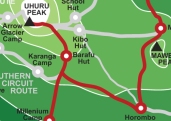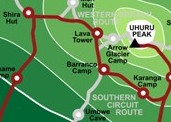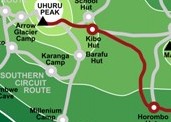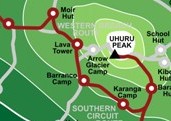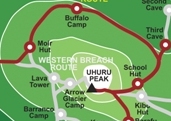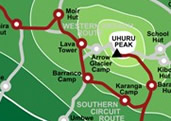history of kilimanjaro routes
Mount Kilimanjaro is a place of legends - a snow capped mountain rising high over the African valley. To the local Chagga people, the snow atop Kilimanjaro was laid by God to protect the land from evil spirits. Geologists were skeptical of written early accounts by early Arabs, Asians and Europeans, who described their sightings of the immense snowy mountain near the equator.
In 1889, German geographer Hans Meyer and Austrian mountaineer Ludwig Purtscheller, accompanied by local residents, recorded the first summit of Mount Kilimanjaro. And with that successful climb, the business of climbing Kilimanjaro was initiated.
Early tourists did not have a choice as to which route to climb, as there was only one – the Marangu route. The original route taken by Meyer and Purtscheller closely matches the Marangu route of today. Mountain huts were built along the path for shelter and supplies. The climbs were limited to 5 days, a very short time period for altitude acclimatization, and as a result many people fell sick. Not many people succeeded.
But eventually, more routes were established, beginning with Machame. The development of the Machame route was a welcome occurrence, as the route was an improvement over Marangu due to its superior acclimatization schedule and better scenery.
For a long time, there was only one or two Kilimanjaro routes that climbers could pick from. Today, there are six major routes (and numerous variations/combinations of routes) which begin at different sides of the mountain and spanning from five to nine days. And with all of these options, choosing Kilimanjaro climbing routes had become far more difficult.
kilimanjaro routes
| Route | Pros and Cons | Days | Distance |
| Northern Circuit | Newest route on Kilimanjaro. Best acclimatization profile. Highest success rate. Most scenic path. Long access drive to trailhead. Very low foot traffic. Longest route. Expensive. | 9 | 90 kilometres (56 mi) |
| Lemosho & Shira |
Great scenery. Great acclimatization profile. High success rate. Long access drive to trailhead. Moderate foot traffic. Longer route. Expensive. | 7-9 | 56 kilometres (35 mi) |
| Machame |
Very popular route. Great scenery. Good acclimatization profile. Moderate success rate. Good option for shorter trek. Lowest cost of the camping routes. | 6-7 | 49 kilometres (30 mi) |
| Marangu |
Original route on Kilimanjaro. Very popular and crowded route. Less difficult trekking. Beautiful rainforest section. Sleep in hut shelters. Uses less porters. Lowest cost. Limited scenery. Poor acclimatization profile. Low success rate. | 5-6 | 64 kilometres (40 mi) |
| Rongai |
Remote route. Low foot traffic. Less difficult trekking. Long access drive to trailhead. Fair acclimatization profile. Moderate success rate. | 6-7 | 65 kilometres (40 mi) |
WHY PEOPLE FAIL ON KILIMANJARO



The primary causes of failure on Mount Kilimanjaro are:
1. Acute mountain sickness (AMS) – Acute mountain sickness, also known as altitude sickness, is a biological reaction caused by the low oxygen content at high altitudes. Symptoms of AMS include headache, dizziness, nausea, vomiting, malaise, fatigue, and shortness of breath. Severe AMS can result in high altitude pulmonary edema (HAPE), fluid in the lungs, and high altitude cerebral edema (HACE), swelling of the brain. Both of these conditions are very serious and can be fatal.
2. Physical exhaustion – climbing Kilimanjaro is a physical exercise, and thus, those who are not in good fitness can become spent due to the constant hiking, day after day. This is most apparent during the long, unforgiving ascent to the summit, which is almost a 4,000 foot climb.
3. Bad weather conditions - Mount Kilimanjaro is so tall that it creates its own weather. Blizzards, heavy rains and strong winds can occur at any time, without warning. During severe weather conditions, the risks on the mountain are exponentially greater as there is a smaller margin for error. Therefore, experienced guides may discontinue trekking when bad weather compromises the safety of the climbers.
4. Other Illnesses - it is possible to contract other illnesses on the mountain. Food poisoning due to poorly prepared food, water-borne illness caused by contaminated water, bacterial and viral infection caused by poor cleanliness, are both fairly common on the mountain, especially amongst those climbing with budget operators who lack a standard of hygiene. When the body is under stress, it is also more susceptible to contracting diseases such as the flu and colds.
5. Injury – all it takes is one wrong foot placement on the rocky mountain terrain to get hurt on Kilimanjaro. Blisters, twisted ankles, sprained wrists, strained backs, painful knees are all injuries that can end a Kilimanjaro trek.
